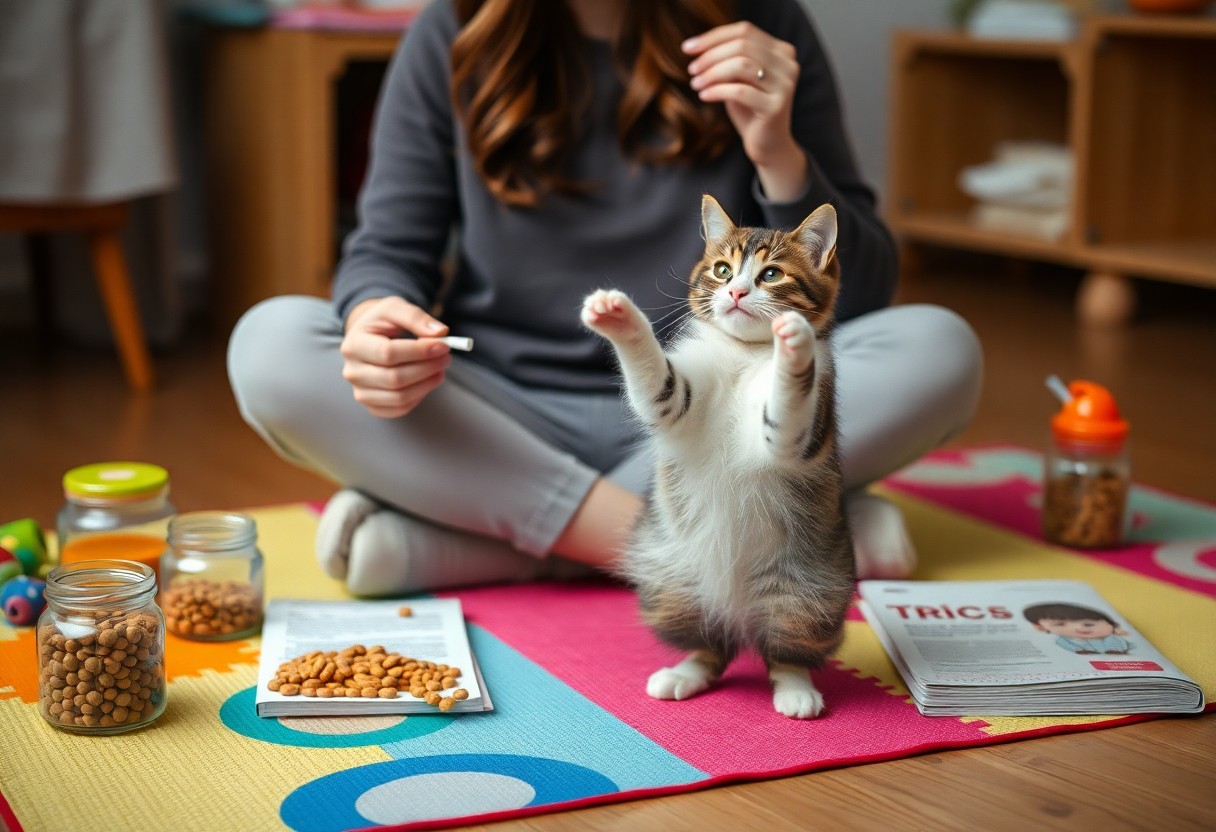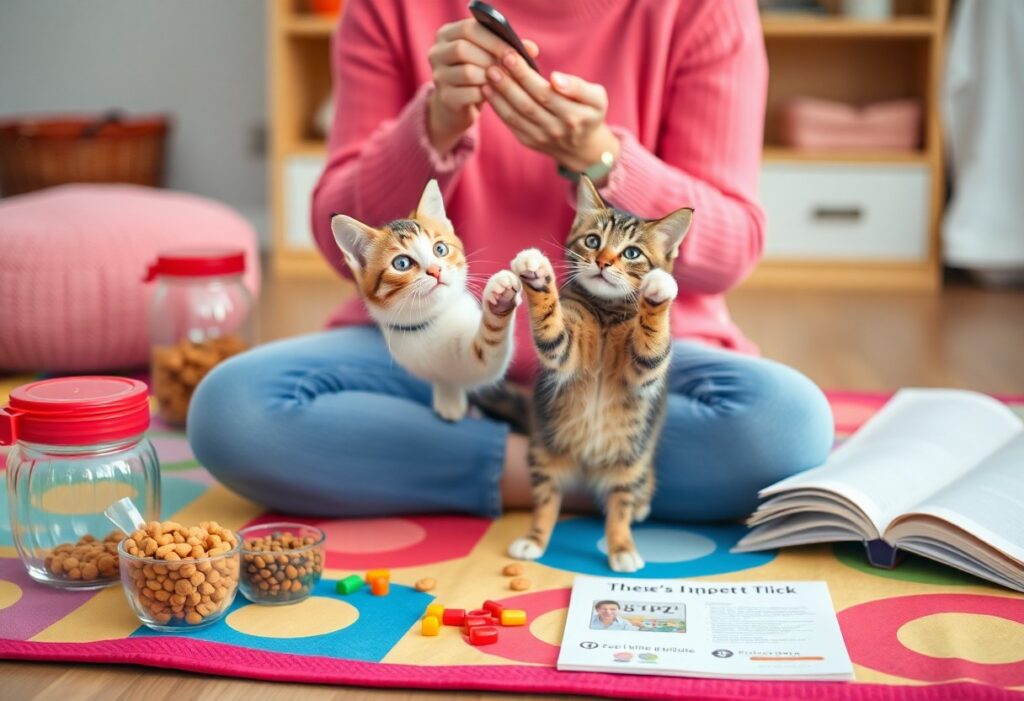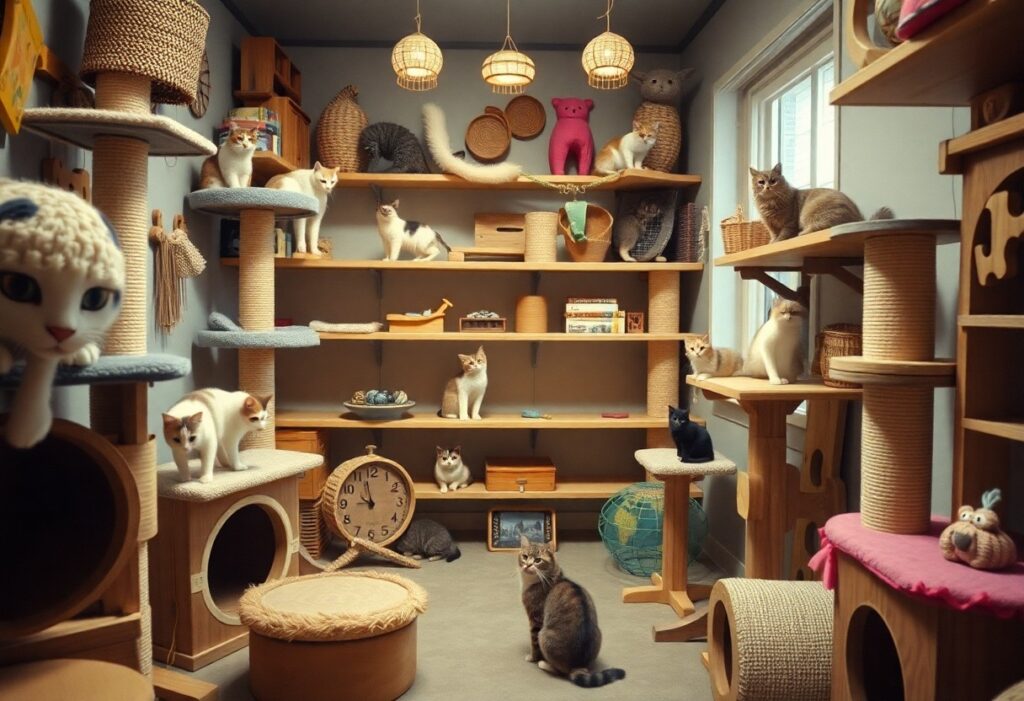Playtime can become a delightful bonding experience when you teach your cat entertaining tricks. Not only does this engage their curiosity and energy, but it also helps you strengthen your bond with your feline friend. With patience, positive reinforcement, and consistent practice, you will be amazed at how quickly your cat can learn to perform impressive feats. This guide will walk you through easy steps to make playtime not just fun, but filled with mental stimulation for you and your cat.

Key Takeaways:
- Begin with simple tricks to build your cat’s confidence and ensure a positive experience.
- Utilize positive reinforcement techniques, such as treats and praise, to encourage and motivate your cat during training sessions.
- Incorporate playtime into training to create a fun and engaging environment that keeps your cat interested and eager to learn.
The Benefits of Teaching Tricks to Your Cat
Teaching your cat tricks goes far beyond just having fun—it’s a valuable opportunity for growth, engagement, and connection. As your cat learns new skills, you will notice improvements in their mental acuity and social behavior. With the right approach, you can transform playtime into a fulfilling experience that benefits both you and your feline companion.
Enhancing Your Cat’s Mental Stimulation
Engaging your cat with tricks stimulates their mind, encouraging problem-solving and cognitive skills. This mental workout can help reduce boredom and prevent destructive behaviors. Frequent practice also promotes a healthy curiosity, ensuring that your feline remains alert and active, particularly as they age.
Strengthening the Bond Between You and Your Feline Friend
Teaching tricks is an excellent way to deepen your relationship with your cat. The process requires patience, trust, and communication, allowing you to create a unique bond as you work together towards mastering each new skill. Celebrating their successes will enhance mutual understanding and affection.
As you and your cat engage in this fun learning journey, you’ll find that each session serves as a unique opportunity to connect. The more time you spend together, the more you will understand your cat’s personality, preferences, and quirks. This shared experience builds a strong foundation of trust, making future interactions smoother and more enjoyable. Moreover, witnessing your cat’s progress not only brings joy to your relationship but also fosters a greater sense of responsibility and commitment to their happiness and well-being.
Essential Tools for Successful Training
To achieve optimal results during your training sessions, having the right tools on hand can make a significant difference. Equip yourself with clickers for effective communication and precise timing, and don’t forget to have a good supply of cat treats to keep your feline motivated. Additionally, consider using toys that engage your cat’s natural instincts, enhancing learning and making tricks feel playful rather than tedious. These necessarys will lay the foundation for a successful training experience, fostering trust and cooperation between you and your cat.
Treats and Rewards: Choosing the Right Motivators
Selecting the perfect motivators for your cat is all about knowing what gets their attention. Opt for high-value treats, such as small pieces of cooked chicken, tuna, or commercial cat treats that your cat loves. Experimenting with different options can help you identify the best reward for your individual cat, ensuring that their desire for the treat motivates them to learn new tricks quickly. Keep it varied to maintain their interest!
Training Environment: Setting Up for Success
A calm and distraction-free environment is necessary for effective training sessions. Choose a quiet space where your cat feels safe and relaxed, free from the chaos of daily life or the temptation of other pets. This controlled atmosphere encourages your cat to focus on you and the task at hand without worrying about outside noises or interruptions. Additionally, ensure that training sessions are brief—about 5-10 minutes—so your cat remains engaged and eager to learn without becoming fatigued.
Setting up the right environment extends beyond just choosing a quiet spot. Ensure your training area is familiar and comfortable for your cat, surrounding them with their favorite items, such as a cozy bed or their preferred toys. Having everything easily accessible helps you transition between tricks, keeping your cat attentive and less likely to wander off. Introducing some low-level background noise, such as soft music, may help some cats concentrate better, emulating a sense of normalcy while they engage with you. Observe their reactions and adjust the environment to create the perfect learning atmosphere tailored to your cat’s unique personality and preferences.

Crafting a Training Strategy: Step-by-Step Approaches
| Step | Action |
|---|---|
| 1 | Establish a distraction-free environment to help your cat focus. |
| 2 | Select a specific trick to start with, such as “high five” or “sit.” |
| 3 | Use positive reinforcement, such as treats or praise, every time your cat successfully performs the trick. |
| 4 | Practice short training sessions daily—about 5 to 10 minutes ensures your cat stays engaged. |
| 5 | Gradually increase difficulty by adding more complex tricks as mastery improves. |
Selecting the Right Tricks: Easy to Complex
Begin with simple tricks that require minimal effort from your cat, such as “shake” or “jump through a hoop.” These foundational skills build your cat’s confidence and create a positive association with training. As your cat becomes comfortable, incrementally introduce more challenging tricks like “roll over” or “fetch.” This progressive approach ensures your cat remains engaged and excited about learning, reducing frustration for both you and your pet.
The Importance of Consistency and Patience
Training requires you to stick to the same cues and rewards each time you practice. By ensuring a consistent training environment and using the same phrases or gestures, your cat can better understand what you expect. Patience is equally vital; if your cat doesn’t grasp the trick immediately, avoid reacting negatively. Instead, keep the atmosphere fun and relaxed, allowing time for your cat to learn at its own pace.
Building a solid foundation in training hinges on maintaining a steady routine. For instance, consistency in your commands and hand signals helps your cat make clear associations between behaviors and rewards. If you switch commands or use varying tones, confusion may arise, causing delays in progress. Allow your cat to learn and adapt without pressure—some may respond quickly, while others could take weeks or even months to grasp new tricks, so enjoy the journey together!

Troubleshooting Common Training Hurdles
Training your cat may present unexpected challenges, but addressing these hurdles can smoothen the learning experience. You might find that your cat isn’t responding as anticipated or even displaying undesired behaviors. Identifying the root of these issues and adapting your approach diligently ensures that both you and your feline companion enjoy the training process. Consider factors like the environment, your cat’s mood, or the methods you’re using, as they play significant roles in shaping the outcomes of your training sessions.
Recognizing and Handling Behavioral Obstacles
Behavioral obstacles can manifest in various forms, such as refusal to engage, excessive aggression, or a lack of interest. To tackle these issues effectively, observe your cat’s body language and vocalizations. Cats often communicate discomfort or disinterest through hissing, growling, or simply wandering off. If your cat exhibits any of these signs, it’s crucial to calm the environment, allowing them to relax before resuming training. Incorporate enticing treats or toys to reignite their motivation. Understanding these indicators helps transform potential setbacks into learning opportunities.
Adjusting Techniques to Match Your Cat’s Personality
Every cat has a unique personality, which significantly influences their learning style. Some may thrive on interactive play, while others prefer gentle guidance at their own pace. Spend time observing how your cat reacts to various stimuli and adjust your training techniques accordingly. For instance, shy cats may benefit from quieter, more gradual training sessions, using high-value rewards to boost their confidence. Meanwhile, more energetic cats might enjoy active play combined with tricks, turning training into a lively game. Finding the right balance fosters a positive learning atmosphere.
Understanding your cat’s personality traits can lead to more effective training outcomes. For example, if your cat is particularly food-driven, incorporating treat rewards into more challenging tricks can excite and motivate them. Alternatively, if your cat is timid, rewarding small successes rather than attempting to push for bigger leaps will ensure they remain engaged without feeling overwhelmed. Tailoring your methods to fit your cat’s personality not only enhances their learning experience but also strengthens the bond you share, making playtime a joy for both of you.
Showcasing Your Cat’s Newly Acquired Skills
After diligently training your feline friend, it’s time to showcase their impressive trick repertoire. Whether it’s the classic “sit” or more advanced maneuvers like rolling over, demonstrating these skills can foster a stronger bond between you and your cat. Consider organizing a small show for friends and family, or even sharing videos on social media. Not only will this highlight your cat’s abilities, but it will also inspire others to engage in similar fun, enriching activities with their pets.
Tips for Effectively Demonstrating Tricks
Presentation is key when showing off your cat’s talents. Keep the following tips in mind to enhance your performance:
- Ensure your cat is well-rested before the demonstration.
- Choose an ideal setting with minimal distractions.
- Use clear verbal commands paired with consistent gestures.
- Reward quickly after each trick for better reinforcement.
- Keep the session short and engaging to maintain your cat’s interest.
Any effective demonstration will highlight your cat’s charm and skills while ensuring a delightful experience for everyone involved.
How to Engage with an Audience: Virtual and Live
Engaging your audience, whether in-person or virtually, adds a dynamic touch to your cat’s performance. Tailor your approach by interacting authentically. For live displays, invite questions and encourage audience participation, such as asking them to call out commands you’ve taught your cat. In a virtual setting, create a live stream with an interactive chat to answer viewer inquiries. This interaction builds rapport, making your pet’s training feel accessible and relatable. Additionally, using entertaining backgrounds or props can enhance the visual appeal, keeping viewers captivated.
Final Words
With these considerations in mind, you can effectively transform your playtime with your cat into an engaging and stimulating experience. By incorporating entertaining tricks that cater to your cat’s natural instincts, you not only enhance your bond but also keep their mind and body active. Be patient, consistent, and most importantly, have fun as you teach your feline friend new skills. This journey not only enriches their life but also brings joy and satisfaction to yours.
FAQ
Q: What types of tricks can I teach my cat?
A: There are a variety of entertaining tricks you can teach your cat! Some popular choices include high-five, spin, roll over, and fetching small toys. Cats are naturally playful, so focusing on tricks that align with their instincts, such as jumping or hiding, can make the process more enjoyable. Start with simpler tricks and gradually progress to more complex ones as your cat becomes comfortable with learning. Utilize positive reinforcement, like treats or praise, to encourage your cat along the way.
Q: How can I make training sessions enjoyable for my cat?
A: To keep training sessions fun and engaging for your cat, make sure to create a relaxed environment free from distractions. Use short intervals, around 5 to 10 minutes, to maintain your cat’s interest without overwhelming them. Incorporating playtime or a favorite toy can enhance the experience, making it feel less like a chore. Always conclude each session on a positive note, rewarding your cat with treats or affection for their effort, irrespective of progress in learning the trick.
Q: What should I do if my cat seems uninterested in learning tricks?
A: If your cat appears disinterested in learning new tricks, it may be helpful to reassess your approach. Ensure the training sessions are short, positive, and engaging. Consider using a variety of rewards such as different treats or toys to see what captures your cat’s attention. It’s also important to recognize that some cats may simply have a less trainable temperament than others. In these cases, focus on building a strong bond through play and affection, which can naturally lead to more willingness to learn tricks over time.











